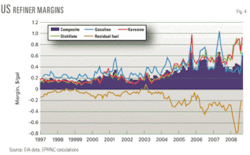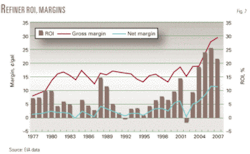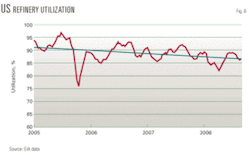Robust worldwide demand growth for middle distillates has resulted in a disproportionate price increase compared to gasoline. The current global refining configuration is misaligned with these recent trends in product demand, a situation that calls for significant investment.
These are the conclusions of a December 2008 report from Energy Policy Research Foundation Inc. (EPRINC) entitled “The US Refining Industry: Background and Perspective for Policy Makers.”
Diesel fuel, which historically sells at a discount to gasoline, now sells at a premium, the report reminds us. And because gasoline margins are now resulting in negative crack spreads, middle distillates are the only significant source of positive margins.
The recent increases in middle distillate prices are largely due to short-run constraints in the global refining industry to adjust its product output to meet adequately rising demand.
Existing US refineries are, “for the most part, technically constrained to relatively small yield shifts, although at some facilities the shift to higher distillate yields has been impressive,” the report said. “New investment in basic capacity expansion might help rebalance the slate of products produced, but most investment has gone to capital equipment for making the existing product slate cleaner and for using lower-quality crudes. As investment takes place in new refineries and/or configuration adjustments are made at existing refineries, we would expect the large price differential between gasoline and distillate to narrow.”
US refining returns on investment are highly volatile but have historically lagged all US manufacturing, the report said. EPRINC examined a sample of refiner stock prices and preliminary data of recent refinery margins and concluded that higher margins and ROIs prevalent for some refiners during 2005-07 are likely over.
Historically, US refinery capacity has increased despite a decline in the number of refineries since petroleum price controls were removed in the late 1970s. Investments have resulted in more robust and efficient operations in fewer but larger plants; refinery complexity has increased substantially.
“As US refining became more complex and capacity more streamlined, the global oil market changed as well,” the report said. “Consumers’ demand for fuels began to outstrip both the supply of produced crude and global refining capacity, creating a tight supply-demand balance where supply was unable to respond to increased demand or accommodate a supply outage without a price spike.”
Ending a period of price stability, crude and product prices—especially diesel and heating fuels—saw prices rise sharply during 2005 to early 2008. A crude and product price reversal of “epic” proportions is currently under way and will likely lead to low rates of return in US refining in 2009, the report said.
The US refining industry is heavily exposed to foreign competition. The most important factor for policy makers, therefore, is to recognize that the industry is well integrated into the world product market and its competitive position is directly tied to its ability to raise capital and operate on as level a playing field as possible, EPRINC said. The alternative is growing reliance on foreign sources for petroleum products.
Refining realignment
The report summarized historical trends in the US refining industry, including the trend towards larger refineries, consolidations, and a shift in the refinery geographies.
The trend toward larger plants began during World War II due to economies of scale. In 1960, the average refinery was about 32,000 b/d; by 1981, that figure nearly doubled to 57,000 b/d; and doubled again by 2007, when the average plant was about 117,000 b/d, the report said.
In the 1970s, US refiners began increasing refinery complexity and consolidating refinery sites in order to control air emissions, produce 100% unleaded gasoline, handle more foreign crude due to reduced domestic output, receive more waterborne crude, and use more natural gas as a refinery input.
According to the report, refining capacity growth in the US has gravitated toward such coastal locations as the Texas-Louisiana coast, West Coast, and the Mid-Atlantic. Waterborne imports now fulfill most US petroleum needs. Refinery expansions have therefore centered on existing units with waterborne transport accessibility and good crude and product pipeline connections.
Exceptions to this general rule, the report said, are landlocked midwestern refineries that receive Canadian crude via pipeline and from Gulf Coast supply points. Some refineries in the Midwest have been consistently upgraded, therefore, and are now receiving feed from Alberta oil sands.
US refinery upgrades
According to the report, investments in US refineries have not led to a barrel-for-barrel increase in refinery throughput. It, however, allows refiners to make products to greater specifications and make them from crudes of decreasing quality.
Some of the added capacity—notably hydrotreating for sulfur reduction—represents “staying in business” investment, replacing “old” products with low or ultralow-sulfur versions, the report said. These investments include coking, FCC, and hydrotreating capacity.
Fig. 1 shows that US refiners have increased coking capacity 1 million b/d since 1991, a 63% increase.
“To some extent, more coking capability has increased product output; more importantly, it has helped maximize the yield of gasoline and distillates from heavier crudes,” the report said. “Additionally, greater coking capability has provided a path toward decreasing output of low-demand heavy fuel.”
Fig. 2 shows that FCC capacity increased 13% since 1991; to 6.3 million b/d from 5.6 million b/d, “reflecting the continued trend toward more intensive processing to increase light product yields from heavier feedstock.”
Fig. 3 shows that hydrotreating capacity has risen to 15.8 million b/d from 9.7 million b/d since 1991.
“Not only does this constitute a 63% increase in capability,” but refiners’ investments ensure that 9 bbl out of 10 “run in US refineries can be hydrotreated,” the report said. “Intensive investment here helps to explain how the transition to low and ultra-low sulfur fuels was accomplished with such success.”
Product margins
US gasoline margins improved steadily during 2004-07 but are currently falling, according to the report. In September 2008, refined product prices remained high due to Hurricanes Ike and Gustav, which caused the closure of more than 21% of US refining capacity. By late October, retail gasoline prices dropped more than 30% from their September peaks and have subsequently fallen dramatically.
Distillate margins were higher in 2008, reflecting worldwide growth, the report said. Currently, distillate—which has had the strongest market—is under price pressure and margins could fall.
Kerosine had stable prices until 2004, when prices and margins rose quickly. World economic growth since 2004 contributed to higher demand, and refiners have struggled to keep pace, the report said. The result is high prices and margins, at least until 2008, when economic conditions began to weaken margins.
Residual fuel (resid) margins have historically been negative and refiners have sold it at a loss simply to increase their cash flow. More advanced processing at high-conversion refineries minimizes resid production; all refineries do not have this amount of conversion, according to the report.
Fig. 4 shows margins for all four products individually, and a composite weighted average margin, calculated by EPRINC. It shows level positive margins in a narrow range for the three main products until 2004. Resid has the same general pattern, except in a slightly negative range, because it sells for less than crude cost.
After 2004, margins for the three products increased. Fig. 4 shows a sharp downturn in resid prices when they failed to keep pace with soaring crude prices.
According to the report, composite margins would have fallen if the three product prices had not risen to offset losses from resid. This shows how important are resid and other bottom-of-the barrel products to healthy refiner margins. Recently, plunging resid margins and lower gasoline margins offset high jet fuel and distillate margins.
Other factors
According to the report, developments with little or no precedent have affected US and global fuel markets during the past decade, often catching refiners, policy makers, and consumers by surprise. These developments include more gasoline and distillate imports and increased demand for middle distillates.
Growth in gasoline imports to the US began in the late 1990s from about 500,000 b/d, reaching a peak of 1.6 million b/d during some high-demand periods in recent years. In September 2008, US gasoline imports averaged about 1.1 million b/d, which was more than 10% of consumption.
In the US gasoline market, competition from international refiners plays a key role in determining prices. Outside US refiners are so entrenched in the US gasoline market that they are regular competitors, adding often-overlooked competitive increment volumes of products, the report said.
Distillate imports are as important in the US as gasoline imports. But the distillate picture is much more complicated than gasoline because exports are also significant, the report said. In some months, net imports are as high as 600,000 b/d, typically peaking during the heating season.
Fig. 5 shows distillate imports and exports. Until recent months, when extremely strong global demand has taken supplies from the US market, the US imported about 7% of its distillate needs. But distillate exports grew during 2008, peaking at 849,000 b/d in August 2008, before declining to 313,000 b/d in September, according to the report. The US has been a net distillate exporter since late 2007.
According to US Energy Information Administration data, all distillate exports in 2008 had a sulfur content of 15 ppm or greater; no ultralow-sulfur diesel was exported. Furthermore, refiners managed to increase distillate production from the average barrel of crude. This continues a trend that started in 2002; its most recent effect was in 2008, when refiners increased distillate yields about 5% of the barrel, mostly reducing gasoline production, the report said.
Increased diesel demand for transportation of all types has caused the middle of the barrel to be the high-growth component of petroleum consumption, the report said. Global economic growth since 2004 resulted in a 3 million b/d increase in distillate consumption.
“Economic development in China, a continued trend toward diesel passenger cars in Europe, and trend growth in a strong US economy all contributed,” the report said. “The growth increment here was the equivalent of two thirds of the increase in refining capacity globally.”
Refiner profitability
EPRINC feels that the true measure of profitability is ROI, which is highly correlated with but differs from, refiner margins. EPRINC uses EIA data from “Performance Profiles of Major Energy Producers” to analyze the refining and marketing segment.
EPRINC calculated US refining ROI for 26 companies in EIA’s Financial Reporting System (FRS) database during 1980-2006. The US refining industry has historically underperformed the entire US manufacturing sector.
During the 1980s and 1990s, refining and marketing ROI averaged 5.2%. For 12 of those years, ROI was less than 5%, according to the report. Returns underperformed the manufacturing sector until 2004, when for the first time in recent history, refining and marketing ROI exceeded 10%.
Because EIA’s FRS data end in 2007, EPRINC extrapolated using quarterly data for the 11-firm FRS subset that reported US net income through second-quarter 2008 in EIA’s publication, “Financial News for Major Energy Companies.”
Fig. 6 shows a large drop in net income of the reporting companies starting with third-quarter 2007 and continuing through second-quarter 2008, when earnings were only 17% of year-earlier levels. Earnings increased in third-quarter 2008 but started eroding before the quarter ended. Fig. 6 shows the year-over-year change at the top of each bar.
EPRINC’s analysis indicates that margin improvements in “recent years have dissipated, and profitability has reverted to historic levels, which are lower than US manufacturing. Recent volatility in oil markets makes generalization difficult, but it appears as if refining profitability—along with crude and product prices—collapsed in late 2008.”
Refiner margins, ROI
Fig. 7 shows US refiners’ actual margins and ROI from the recent EIA report, “Performance Profiles of Major Energy Producers 2007.” These data are expressed in nominal dollars, based on data provided to EPRINC from the EIA (the actual report expresses these figures in 2007 constant dollars).
Margin data in Fig. 7 are net margins, meaning total production costs for the comprehensive refinery product slate were subtracted from revenues realized from the sale of all products. This gives an overview of industry profitability, while not detailing the role of products individually, according to the report.
In 2007, average margin on refined products was $4.78/bbl (11.3¢/gal), a decrease from $4.85 (11.5¢) in 2006. These are historically high margins and coincident with high ROIs, 21.6% and 25.6%, respectively.
Margins, however, are volatile. As recently as 2002, margins were $0.21/bbl (0.5¢/gal). That corresponded to an accounting ROI of –1.7%.
Lower utilization
Refinery utilization rates influence profitability that is unrelated to refined product prices, according to the report. Individual product margins are calculated without accounting for operating costs; that can give an oversimplified and misleading picture of higher profitability than quarterly or annual reports will show.
High utilization means fixed costs are spread among more barrels of products, lowering unit costs and contributing to better ROI.
Refinery operating rates have been declining since 2005, when ROI and refinery utilization both peaked (Fig. 8). During some periods in 2005, capacity utilization exceeded 96%, a very high rate. For 2005 as a whole, utilization averaged 90.5% despite outages from Hurricanes Rita and Katrina.
Fig. 8 also shows a downward trend in utilization—it has fallen to 88.8% in 2007, from 89.3% in 2006 and 90.5% in 2005. Utilization for the first 8 months of 2008 is only 86.4%.
The factors lowering utilization are falling petroleum product demand, greater use of ethanol, and more gasoline imports. The latter is due to a surplus in Europe, with significant amounts of discounted gasoline exported to the US, according to the report.










